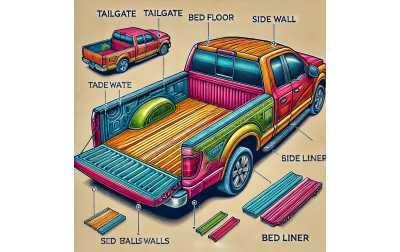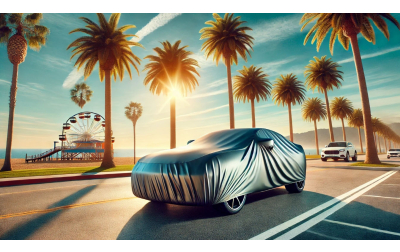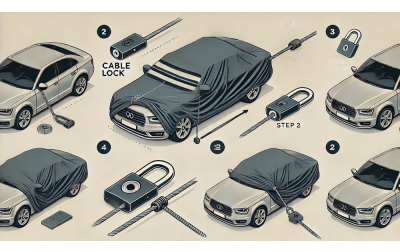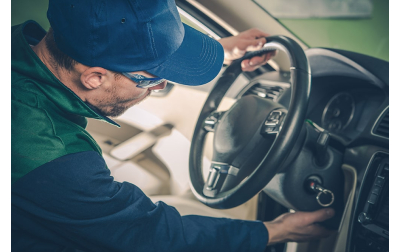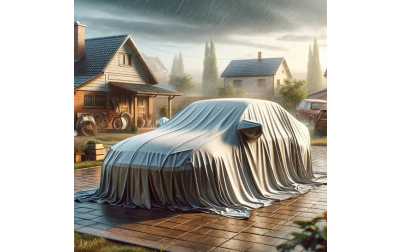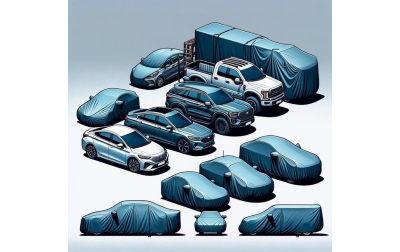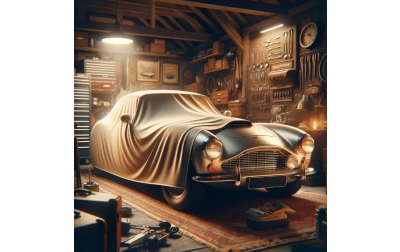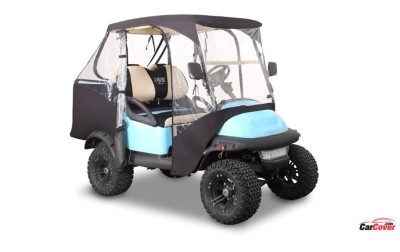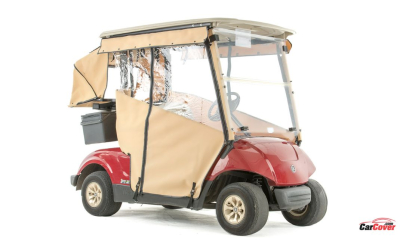
California Car Covers: The Ultimate Guide to Protecting Your Vehicle in the Golden State
Your car sitting under that California sun isn't as safe as you think. Real talk: California's climate is a beast. Your ride's paint job is getting roasted by UV rays, bombarded by rain, coated in dust, and attacked by salty coastal air. We're about to break down why a top-tier car cover is your best friend in this crazy state.
In this guide, we'll cover everything you need to know about protecting your vehicle in California, including:
- Weather Conditions in California: Learn about the impact of California's sunny and hot climate, rainy seasons, and snow in mountain regions on your vehicle.
- Dust and Environmental Factors: Understand how dust, dirt, pollution, and acid rain can damage your car and how the right car cover can help.
- Additional Environmental Factors: Discover how salt air, bird droppings, and tree sap can wreak havoc on your car's exterior and how to protect against them.
- Selecting the Right Car Cover for Your Needs: Get tips on choosing the right material, durability, fit, and special features for your car cover.
- Maintenance and Care for Car Covers: Find out how to clean, store, and inspect your car cover to ensure it lasts and continues to protect your vehicle effectively.
Protecting your car in California requires a comprehensive approach, considering all environmental factors. Investing in a high-quality car cover is essential to maintaining your vehicle's condition and appearance. Don't wait until your car shows signs of damage – take action now to ensure its longevity and appearance.
Weather Conditions in California
Sunny and Hot Climate
That sun isn't just giving you a tan; it's frying your car's paint, cracking that leather interior. Places like LA and Palm Springs get hotter than a stovetop. Prolonged heat exposure? Say goodbye to vibrant paint and hello to cracked dashboards and seats. You need a car cover that's got UV-blocking powers. Look for covers made with UV-resistant materials, which can prevent up to 99% of UV damage. Don't cheap out – a flimsy cover is like using dollar store sunscreen on a beach day.
Heat Protection
Heat warps plastics and dries out rubber seals, leading to leaks. A heat-reflective car cover is essential. These covers block UV rays and reflect sunlight, keeping your car cooler. This is crucial for preserving the interior and ensuring that your car's electronics and batteries aren't subjected to extreme temperatures.
Rainy Seasons
California might be known for its sunshine, but when it rains, it floods. Think about the winter months when the rain comes down in buckets. That water's gonna find every nook and cranny of your vehicle. Moisture leads to rust, mold, and electrical problems. You need waterproof, not just water-resistant. Your car cover should be your ride's raincoat, not a flimsy poncho. Look for covers with multiple layers, including a waterproof outer layer and a soft, absorbent inner layer to prevent scratches.
Water Resistance and Breathability
It's a balance. While you want a cover that's impermeable to water, it also needs to breathe to allow moisture that's already inside to evaporate. Otherwise, you're just trapping water against your car's surface, which can be just as bad as leaving it exposed.
Snow in Mountain Regions
California's geography is wild – sunny beaches to snowy mountains. If you're hitting spots like Lake Tahoe or Big Bear, snow and ice are your new enemies. Snow and ice can damage your car's paint and bodywork. Snow buildup can lead to water seepage, and ice can cause scratches and dents. You need a car cover that can handle these harsh conditions. A thermal car cover with extra padding provides insulation, keeping your car's exterior safe from the elements.
Thermal Protection
Look for covers with thermal protection to keep your car's temperature stable. These covers usually have a thicker, quilted design that not only insulates but also cushions against hail and ice. This added protection can be crucial in preventing cold damage to your engine and battery.
Dust and Environmental Factors
Dust and Dirt
Dust is relentless. California's desert regions, like the Mojave and areas near Joshua Tree, whip up dirt and sand like there's no tomorrow. Dust can scratch your car's paint and infiltrate the interior, causing long-term damage. A good cover keeps your car looking fresh, like it just rolled out the showroom. Choose covers with fine weaves that can block even the smallest particles of dust and dirt.Pollution
Urban areas like Los Angeles are notorious for their smog and pollution. Airborne pollutants can settle on your car, causing chemical damage to the paint and metal. Pollution-resistant materials are essential for car covers in these regions. These covers are designed to be easy to clean, ensuring that pollutants don't stick around long enough to do damage.
Acid Rain
In areas with high pollution, acid rain can be a real problem. When it rains, pollutants in the air mix with water vapor to form acid rain, which is highly corrosive. This can damage your car's paint and metalwork. A car cover that's resistant to acid rain provides a vital layer of protection.
Additional Environmental Factors
Salt Air in Coastal Regions
Living by the coast has perks, but it's no vacation for your car. Salt air is highly corrosive and can cause rust on your car's body and undercarriage. If you're near coastal areas like San Francisco or San Diego, you need a cover with salt protection. These covers provide a barrier against salt and moisture, preventing corrosion and keeping your car in top condition.
Bird Droppings and Tree Sap
Bird droppings and tree sap are more than annoyances; they're corrosive and can eat through your car's paint if not removed quickly. Parking under trees might seem like a good idea for shade, but it often leads to sap and droppings. A high-quality car cover can protect against these substances, saving you countless hours of cleaning and potentially costly paint repairs. Choose covers that are easy to clean and resistant to these types of stains.
Protective Layer
Look for car covers that offer a protective outer layer specifically designed to repel bird droppings and tree sap. Some advanced covers come with a special coating that makes it easier to wash off these substances without damaging the fabric or your car's paint.
Selecting the Right Car Cover for Your Needs
Material Selection
Not all car covers are created equal. You need to choose the right material for your specific needs. Breathable fabrics are crucial to prevent moisture buildup and mold. Materials like polypropylene are excellent for breathability and durability. For maximum protection, consider multi-layered covers. The outer layer should be tough and waterproof, the middle layer for UV protection, and the inner layer should be soft to avoid scratches.
Durability
Durability is key. You don't want a cover that's going to fall apart after a few uses. Look for reinforced seams and high-quality stitching. The best car covers are made from materials that can withstand the elements for years without degrading.
Fit and Customization
Custom-fit car covers are designed to hug the contours of your vehicle, providing the best protection. Unlike universal covers, which can be loose and allow dust and moisture to get in, custom-fit covers offer a snug, secure fit. They come with elastic hems, grommets, and straps to keep the cover in place, even in strong winds. If you have modifications or additional accessories on your car, make sure to account for these when selecting a custom cover.
Securing Mechanisms
The best car covers have multiple securing mechanisms to ensure they stay put. Elastic hems provide a snug fit around the bottom of your car, while grommets and straps can be used to secure the cover under the car. This prevents the cover from being blown off in high winds or easily removed by thieves.
Special Features
When choosing a car cover, consider additional features that can provide extra protection. UV protection is crucial in sunny California. Covers with high UV ratings can prevent up to 99% of UV damage, keeping your car's paint and interior in pristine condition. Waterproofing is essential for regions with significant rainfall. Ensure the cover has multiple layers to block water while allowing moisture to escape. Soft inner linings are important to prevent scratches on your car's paint. Look for covers with fleece or microfiber linings that provide a gentle touch.
Maintenance and Care for Car Covers
Regular Cleaning
Keeping your car cover clean is just as important as using it. Dirt and debris can accumulate on the cover and cause scratches when it's moved. Follow the manufacturer's washing instructions to ensure longevity. Most covers can be hand washed with mild soap and water. For tougher stains, a specialized car cover cleaner may be necessary.
Storage Tips
When not in use, store your car cover in a cool, dry place. Avoid folding it while wet, as this can lead to mold and mildew growth. Using a storage bag can help protect the cover from dust and damage.
Inspection and Replacement
Regularly inspect your car cover for signs of wear and tear. Look for holes, tears, and worn-out elastic. If the cover no longer fits snugly or shows significant damage, it's time to replace it. Investing in a high-quality car cover is essential to maintaining your vehicle's condition.
Conclusion
Recap the key points discussed in the guide. Protecting your car in California requires a comprehensive approach, considering all environmental factors. Encourage readers to invest in a high-quality car cover to protect their vehicle from California's unique environmental challenges. Don't wait until your car shows signs of damage – take action now to ensure its longevity and appearance. Provide a call to action for readers to visit CarCover.com to find the perfect car cover for their needs. Mention any special offers or discounts to incentivize immediate purchases. Your ride deserves the best, so give it the protection it needs with a top-tier car cover from CarCover.com.
FAQ SECTION
Are Car Covers Illegal in California?
You might be wondering if using a car cover is even legal in California. The short answer is yes, car covers are legal. However, there are some regulations you should be aware of. For example, when parked on public streets, your license plate must remain visible. Some car covers come with built-in license plate windows to comply with this requirement.
Local laws may vary, so it's a good idea to check specific municipal codes if you frequently park on the street. In some areas, covering a car parked on public property for extended periods may attract fines or penalties. Always ensure that your car cover doesn't obstruct the view of any legally required decals or permits, like parking permits.
If you're using a car cover in a private driveway or garage, there are no restrictions. Just make sure it's secured properly so it doesn't blow away or cause any hazards. It's also worth noting that while car covers are legal, they should not be used to hide vehicles that are in violation of other laws, such as expired registration or parking in prohibited areas.
What makes a car cover UV-resistant, and why is it important in California?
A car cover is UV-resistant when it's made from materials that can block or absorb UV rays, such as polyester with added UV inhibitors. In California, where the sun is intense, UV resistance is crucial to prevent your car's paint from fading, the interior from cracking, and other sun-related damage.
How do I choose the right car cover for my specific vehicle model?
To choose the right car cover, consider factors such as your vehicle's size, shape, and any accessories (like roof racks or spoilers). Custom-fit car covers are designed to match the exact dimensions of your car, providing the best protection. You can usually find these covers by searching for your car's make, model, and year on specialized websites like CarCover.com.
Are car covers effective against all types of weather conditions in California?
Yes, high-quality car covers are designed to protect against various weather conditions including sun, rain, dust, and even snow in mountain regions. Look for covers with multiple layers and features like UV resistance, waterproofing, and thermal insulation to ensure comprehensive protection.
What materials should I look for in a high-quality car cover?
High-quality car covers are often made from materials like polypropylene for breathability, polyester for durability, and specialty fabrics with UV inhibitors. Multi-layered covers with a tough outer layer, a middle UV-protective layer, and a soft inner layer for scratch prevention are ideal.
How can I properly secure my car cover to ensure it doesn't blow away in strong winds?
Properly securing a car cover involves using features like elastic hems, grommets, and straps. Elastic hems ensure a snug fit, while grommets and straps can be used to tie the cover under the car, preventing it from blowing away in strong winds.
Is there a difference between water-resistant and waterproof car covers?
Yes, water-resistant car covers can repel water to a certain degree but may eventually let moisture through during heavy rain. Waterproof car covers provide a complete barrier against water, ensuring your car stays dry even in heavy downpours. For the best protection, choose a cover labeled as waterproof.
How often should I clean my car cover, and what's the best way to do it?
Car covers should be cleaned regularly, especially if they accumulate dirt and debris. Most covers can be hand washed with mild soap and water. Follow the manufacturer's instructions for the best results. For stubborn stains, you might need a specialized car cover cleaner.
8. Can car covers prevent rust and mold formation on my vehicle?
Yes, car covers can help prevent rust and mold by keeping moisture, dust, and debris off your vehicle. However, it's important to choose a breathable cover that allows any trapped moisture to evaporate, reducing the risk of rust and mold formation.
Are there any specific regulations in California regarding the use of car covers on public streets?
In California, car covers are legal, but there are regulations to consider. For instance, your license plate must remain visible when parked on public streets. Some covers come with built-in license plate windows to comply with this rule. Additionally, local laws may vary, so check specific municipal codes regarding extended use of car covers on public property.
What are the benefits of using a custom-fit car cover compared to a universal one?
Custom-fit car covers offer a snug fit that closely contours your vehicle, providing superior protection against the elements and reducing the risk of wind lifting the cover. They also typically feature better securing mechanisms and account for any unique features of your car. In contrast, universal covers may be looser, allowing dust and moisture to get in and offering less overall protection.

